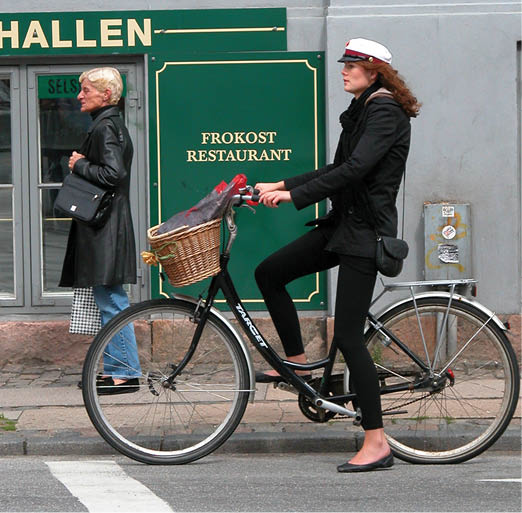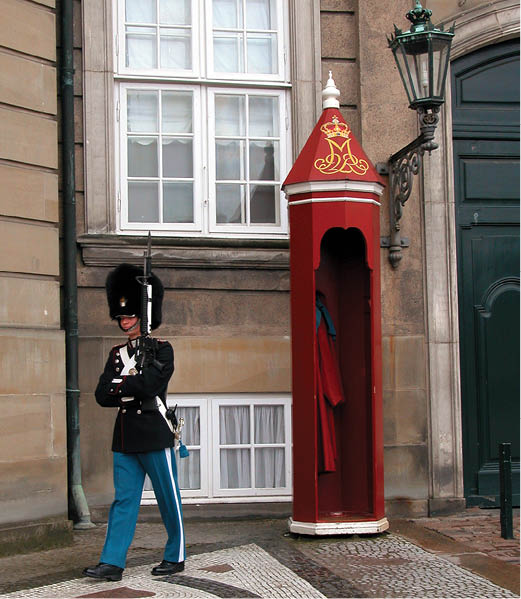Denmark


Pedestrian and bicycle friendly Copenhagen
Smallest of the Scandinavian countries, the Kingdom of Denmark once ruled its larger Nordic neighbours and was so feared by the English they paid the Danes a medieval land tax called Danegeld to fend off raids. Today Denmark is better known for modern design than military conquest. Characterized by clean lines and an elegant yet functional style, Danish-designed products turned Finn Juhl and Arne Jacobsen, among others, into household names.
With a population of 5.6 million, Denmark is densely populated. It is also, by land area, one of the smallest countries in Europe at 16,600 square miles. A drive from the northern border to the southern border can be completed in about four hours. Denmark consists of Jutland (the mainland) and several hundred islands of varying size that are interconnected by bridges and ferries. Zealand is the largest island and is where Copenhagen is situated, at the entrance to the Baltic Sea.
Map of Denmark

Denmark’s low-lying countryside contains rolling hills clad in green fields of rye grass and other crops bordered by groves of beech trees. Jutland’s southern border abuts Germany and those who live along this castle-dotted frontier like to display their Danish patriotism by painting their houses white and their doors red – colours of the Danish flag.

Queen Margrethe I
Denmark is a constitutional monarchy and its reigning monarch is Queen Margrethe II, who was crowned in 1972. The Faeroe Islands and Greenland are self-governing dependencies within the Danish realm. The Danish West Indies were a colony but sold to America in 1917 and renamed the Virgin Islands of the United States.
Lutheranism is the country’s official religion, although relatively few Danes attend church on a regular basis. Danish is the official language and most Danes speak fluent English. The Danish alphabet is similar to the English alphabet, but with three extra vowels at the end. The Danes’ spelling of their country is Danmark. Denmark’s country code for international calls is +45.
Denmark’s unit of currency is the krone (DKK), which divides into 100 ore (pronounced or-a). The approximate exchange rate is US$1 = 6.5 kroner (£1 = 10 kroner). Major credit cards are widely accepted except when buying bus tickets. A 15% service charge is automatically added to hotel and restaurant bills and to taxi fares. On purchases of more than DKK 300, non-EU citizens can obtain a tax refund by first obtaining a tax-free form at the store of purchase. Global Blue has customer services offices at Illums Bolighus’s downtown location (Amagertorv 10 on the Strøget) and their airport location (Terminal 2 Arcade). For instructions on obtaining a tax refund, visit www.global-blue.com.

Royal guard outside Amalienborg Palace.
Denmark’s earliest settlers arrived in the Jutland in about 10,000 BC but it wasn’t until the age of the Vikings that the world began to take notice of the Danes as they launched repeated raids on Western Europe. During this era of Danish expansion, Harold Bluetooth – king of Denmark and conqueror of Norway – turned his back on Norse paganism and embraced Christianity for himself and his subjects. To commemorate this momentous event, Harold ordered the raising of a runic stone in the royal town of Jelling on the Jutland mainland. Now a UNESCO World Heritage Site, this 10th-century stone bears an inscription describing Harold’s achievements and marks the creation of Denmark as a nation state.
In 1397, Queen Margrethe I instigated the political union of Denmark, Sweden and Norway, and had her grandnephew Erik of Pomerania crowned king of all three realms at Kalmar Castle in Sweden – a union that lasted for over a century. With a brilliant royal court, Denmark thrived. However, upon siding with Napoleon in the French Revolutionary Wars, Denmark was attacked by England and its naval fleet destroyed by Horatio Nelson in the Battle of Copenhagen (1801).
More setbacks came when Denmark was defeated by Prussia in 1864 and lost Schleswig-Holstein in the Jutland. Yet, despite losing a third of its territory, Denmark prospered by re-educating its farmers at rural folk schools. A modern system of public education was introduced in the early 1800s, which encouraged a flourishing culture of literature and philosophy led by Hans Christian Andersen and Søren Kierkegaard. In 1849 a new constitution was signed by Frederick IV, bringing to an end the country’s absolute monarchy and establishing Denmark as a constitutional monarchy. This historic event is commemorated each June 5 with a national holiday called Constitution Day,
Denmark remained neutral during WWI and recovered North Schleswig in 1920. German forces invaded Denmark in 1940 and King Christian X, the popular “Equestrian King,” symbolized Danish defiance by riding alone on horseback through the streets of Copenhagen. Most of Denmark’s Jewish population (including refugees from other countries) escaped to Sweden with help from the Danish resistance. Liberated by British troops in May of 1945, Denmark joined the North Atlantic Treaty Organization (NATO) in 1949 and the European Economic Community in 1972 but has retained its own currency. Denmark’s per-capita income is among the highest in the world, and its economy has been rated among the world’s freest for conducting business.
Copenhagen is both historic and hip, with a pleasing mix of old world charm and modernist architecture. Considered one of the world’s most livable cities, Copenhagen is – in the words of Danish architect Jan Gehl – a reconquered city. Where cars once clogged main arteries and central squares, people now stroll along the pedestrian-only streets and gather in squares to enjoy the fountains, public art and open-air cafés. This transformation began back in 1962 when the Strøget – the city’s high street – was closed to car traffic. Additional streets and squares were, over time, emptied of cars, and today the city has an extended network of pedestrian-only promenades connected by dozens of bicycle paths.
Copenhagen is Denmark’s capital and largest city, with a population of 1.2 million. Koben Havn means merchants’ harbour and the city began as a fishing village. By the early 11th century Copenhagen was an important trading port at the entrance to the Baltic Sea where it exacted tolls from ships passing through the narrow Øresund strait. In 2000, completion of the Øresund bridge between Copenhagen and Malmø provided southern Sweden with its first direct land-link to continental Europe.
